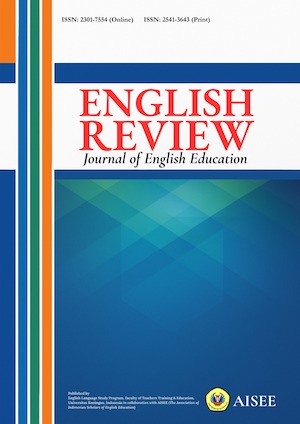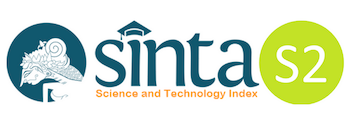STUDENTS’ PERCEPTIONS OF THE IMPLEMENTATION OF DIALOGIC TEACHING FOR IMPROVING SPEAKING SKILLS AT A UNIVERSITY IN WEST JAVA
Abstract
In the present day, English has become a crucial language that individuals must acquire proficiency in. It has been extensively taught as a second language in many locations throughout the globe for a considerable period of time. In the Indonesian context, the tertiary students seem to still lack of English skills despite prolonged duration of learning English. Therefore, an effective teaching strategy is needed to teach English to tertiary students for the best outcomes possible. An experimental study to investigate whether Dialogic Teaching strategy works well to improve English speaking skills was conducted at a university in West Java. In particular, this study reveals the students’ perceptions of the implementation of Dialogic Teaching in a speaking class through the use of focus group discussion involving six participants of low, medium and high speaking skills in English. A qualitative analysis was conducted and some findings were found, including: (1) students being more motivated when under pressure; (2) students earning confidence boost; (3) students acquiring creativities in presenting ideas; (4) students engaging in a dialogic discussion; (5) students wanting a balanced classroom activity; and (6) students aspiring to have outdoor learning activities.
Keywords: Dialogic teaching; Perception; Speaking class; Speaking skills; Tertiary Education;
References
Alexander, R. (2020). A dialogic teaching companion. Routledge.
Alexander, R. (2018). Developing dialogic teaching: genesis, process, trial. Research Papers in Education, 33(5), 561–598. https://doi.org/10.1080/02671522.2018.1481140
Alexander, R. (2017). Towards dialogic teaching: Rethinking classroom talk (5th ed.). York, UK: Dialogos.
Alexander, R. (2008). Culture, dialogue and learning: Notes on an emerging pedagogy. In N. Mercer, & S. Hodgkinson (Eds.). Exploring talk in school (pp. 91–114). London: Sage.
Alexander, R. (2005). Talk for learning: The second year. Northallerton, UK: North Yorkshire County Council.
Abrar, M., Mukminin, A., Habibi, A., Asyrafi, F., & Marzulina, L. (2018). “If our English isn’t a language, what is it?” Indonesian EFL student teachers’ challenges speaking English. The Qualitative Report, 23(1), 129–145.
Albino, G. (2017). Improving speaking fluency in a task-based language teaching approach: The case of EFL Learners at PUNIV-Cazenga. SAGE Open, 7(2), 215824401769107. https://doi.org/10.1177/2158244017691077
Ariyanti, A. (2017). Foreign language anxiety in academic writing. Dinamika Ilmu, 17(1),143–152. https://doi.org/10.21093/DI.V17I1.815
Beilock, S. L., & DeCaro, M. S. (2007). From poor performance to success under stress: Working memory, strategy selection, and mathematical problem solving under pressure. Journal of Experimental Psychology: Learning, Memory, and Cognition, 33(6), 983–998.
https://doi.org/10.1037/0278-7393.33.6.983
Boyce, C., & Neale, P. (2006). Conducting in-depth interviews: A guide for designing
and conducting in-depth interviews for evaluation input. New York:
Pathfinder International.
Cronin, Z. (June 24, 2022). The need for real-world examples in the classroom.
https://www.kiddom.co/real-world-examples-in-the-classroom/
Cui, R., & Teo, P. (2020). Dialogic education for classroom teaching: a critical review.
Language and Education, 35(3), 187–203.
https://doi.org/10.1080/09500782.2020.1837859
Davies, M., Kiemer, K., & Meissel, K. (2017). Quality Talk and dialogic teaching—an
examination of a professional development program on secondary teachers’ facilitation of student talk. British Educational Research Journal, 43(5), 968-987.
Doff, A. (23 February 2022). Language for real
life: Developing conversation skills in English. https://www.cambridge.org/elt/blog/2022/02/23/developing-conversation-skills-in- english/
Dornyei, Z. (2007). Research Methods in Applied Linguistics. Oxford: Oxford University Press.
Elhassan, I., & Adam, M. (2017). The impact of dialogic teaching on English language
learners’ speaking and thinking skills. Arab World English Journal, 8(4), 49–67.
https://doi.org/10.24093/awej/vol8no4.4
Fisher, R. (2007) Dialogic teaching: Developing thinking and metacognition through philosophical discussion. Early Child Development and Care, 177(6), 615–631.
García-Carrión, R., López de Aguileta, G., Padrós, M., & Ramis-Salas, M. (2020). Implications for social impact of dialogic teaching and learning. Frontiers in Psychology, 11.
https://doi.org/10.3389/fpsyg.2020.00140
Hajar, I & Rahman, A. (2022). High school students’ difficulties in English speaking
Skills of Namlea, Buru Island. Exposure Journal, 11(1), 31-40.
Halloush, L., Abdelrahman, A.B & Abu-Dalbouh, M. (2021). Effect of using dialogic teaching method on seventh-grade students’ performance in speaking skill. Jordan Journal of Educational Sciences, 17(4), 649-662.
https://doi.org/10.47015/17.4.11
Inayati, N & Karifianto, D.W. (2022). Autonomous online English language learning in Indonesian higher education contexts. MEXTESOL Journal, 46(1), 2022.
http://www.mextesol.net/journal/index.php?page=journal&id_article=45940
Indrianty, S. (2016). Students’ anxiety in speaking English (A case study in one hotel and tourism college in Bandung). ELTIN Journal, 4(1), 28–39.
Irawan, R., & Warni, S. (2018). EFL learners’
speaking anxiety in an EOP Program.
Journal of ELT Research, 3(2), 193–203.
https://doi.org/10.22236/JER_Vol3Issue
Kahng, J. (2019). Teaching and researching speaking skills: Theory and research-based practices. Routledge.
Kazepides, T. (2012). Education as dialogue. Educational Philosophy & Theory, 44(9), 913–925.
Kasmaini., Danim, S., Kristiawan, M., Zahrida., Sufiyandi., & Maharrini, D. (2023). Improving English students’ speaking skills through an action learning strategy. English Review: Journal of English Education, 11(1), 143-152. DOI: https://doi.org/10.25134/erjee.v11i1.7232
Khasbani, I., & Seli, F. (2021). The impact of role-play on students' speaking performance. Linguists: Journal of Linguistics and Language Teaching, 7(2), 1-15.
http://dx.doi.org/10.29300/ling.v7i2.5216
Kurniawana, I., Sabaruddina, S & Jayanti, F.G. (2018). An analysis of students’ English
speaking skill at coastal schools of Bengkulu City, Indonesia. Journal of English Language Studies, 3(1), 18-30. http://dx.doi.org/10.30870/jels.v3i1.2212
Khasawneh, M. A. S. (2021). Language skills and their relationship to learning difficulties in English language from the students’ point of view. Science and Education, 2(9), 261-272.
Kim, M.Y., & Wilkinson, I. (2019). What is dialogic teaching? Constructing, deconstructing, a reconstructing a pedagogy of classroom talk. Learning, Culture and Social Interaction, 21, 70-86.
Lichtman, M. (2010). Qualitative research in education: a user’s guide (2nd Edition). Sage: California.
Liubashenko, O., & Kornieva, Z. (2019). Dialogic interactive speaking skills assessment in the experiential teaching of technical English to tertiary school students. Advanced Education, 6(13), 18-25.
Mahtawarmi, Y. (2019). Improving students’ speaking skill by using problem-based learning model (Unpublished master’s thesis). Ar-Raniry State Islamic university.
Mazouzi, M. S. (2013). Analysis of Some Factors Affecting Learners’ Oral Performance (Unpublished Master’s Thesis). University of
Biskra.http://archives.univ-biskra.dz/bitstream/123456789/4772/1/PEOPLE1.pdf
Mukminin, A., & Arif, N. (2015). EFL Speaking anxiety among senior high school students and policy recommendations. Journal of Education and Learning, 9(3), 217–225.
Miles, M.B., Huberman, A.M. and Saldana, J. (2014). Qualitative data analysis: a methods sourcebook. Sage: London.
Niknezhad, F.N., Khodareza, M. R., & Mashhadi, D.H. (2020). Promoting dialogic talk in a speaking classroom: rethinking Bakhtinian pedagogy. Journal of English Language Pedagogy and Practice, 13(26), 160-181.
Oldehaver, J. (August 17, 2023). Using dialogic approaches to deepen and extend students’ thinking and learning. https://theeducationhub.org.nz/using-dialogic-approaches-to-deepen-and-extend-students-thinking-and-learning/
Parudani, I., Effendi, T., Rahmi, G., & Syafrudin, S. A. (2021). Struggling Indonesian EFL university students going to mall: any significant impacts? Journal of Language and Literature, 9(2), 172–182. https://doi.org/10.35760/jll.2021.v9i2.5108
Rapanta, C., & Felton, M. K. (2021). Learning to argue through dialogue: A review of instructional approaches. Educational Psychology Review, 34(2), 477–509. https://doi.org/10.1007/s10648-021-09637-2
Saldaña, J. (2011). Fundamentals of qualitative research. New York: Oxford University Press
Sampelolo, R., Tandikombong, M., Pongsapan,
N. P., & Lura, H. (2021). A study of
speaking common university learner
barriers in Indonesian context. Klasikal:
Journal of Education, Language
Teaching and Science, 3(3), 127–131.
https://doi.org/10.52208/klasikal.v3i3.131
Sirait, D. Y. L. (2015). Junior high school students’ speaking anxiety in English class [Doctoral dissertation]. FBS-UKSW.
Sedlacek, M., & Sedova, K. (2017). How many are talking? The role of collectivity in
dialogic teaching. International Journal of Educational Research, 85, 99-108.
Sharon, T. (June 15, 2018). Why stressed minds are more decisive. BBC. https://www.bbc.com/future/article/20180613-why-stressed-minds-are-better-at-processing-things
Sosnowski, M. J., & Brosnan, S. F. (2023). Under pressure: the interaction between high-stakes contexts and individual differences in decision-making in humans and non-human species. Animal Cognition, 26(4), 1103–1117.
https://doi.org/10.1007/s10071-023-01768-z
Tian, S., & Mahmud, M. (2018). A Study of academic oral presentation anxiety and strategy employment of EFL Graduate Students. Indonesian Journal of EFL and Linguistics, 3(2), 149–170.
https://doi.org/10.21462/IJEFL.V3I2.78
Toro, S. (August 6, 2021). How to engage more students in classroom discussions.
https://www.edutopia.org/article/how-engage-more-students-classroom-discussions
Vrikki, M., Wheatley, L., Howe, C., Hennessy, S., & Mercer, N. (2018). Dialogic practices in primary school classrooms. Language and Education, 33(1), 85–100. https://doi.org/10.1080/09500782.2018.1509988
Zhang, Y., & Wildemuth, B., M. (2009). Unstructured interviews. In B. M.
Wildemuth (Ed.), Applications of social research methods to questions in
information and library science (pp. 222-231). London: Libraries Unlimited.
All articles published in English Review: Journal of English Education (ERJEE) are licensed under the Creative Commons Attribution 4.0 International License (CC BY 4.0).
Copyright Ownership
Authors retain the copyright of their articles and grant ERJEE the right of first publication. The journal is granted a non-exclusive license to publish, reproduce, and distribute the article in any format, medium, or platform, provided that proper credit is given to the original authors.
License Terms – CC BY 4.0
Under the Creative Commons Attribution 4.0 International License, others are free to:
- Share — copy and redistribute the material in any medium or format
- Adapt — remix, transform, and build upon the material for any purpose, even commercially
As long as they:
- Provide appropriate credit to the original author(s) and source
- Provide a link to the license (https://creativecommons.org/licenses/by/4.0/)
- Indicate if any changes were made
There are no restrictions on the reuse, reproduction, or adaptation of published articles as long as attribution is properly given.
Author Warranties
By submitting a manuscript to ERJEE, authors confirm that:
- The work is original and does not infringe any existing copyright.
- The manuscript has not been previously published and is not under consideration elsewhere.
- All sources and references are appropriately acknowledged.
- Necessary permissions have been obtained for any copyrighted materials used.









